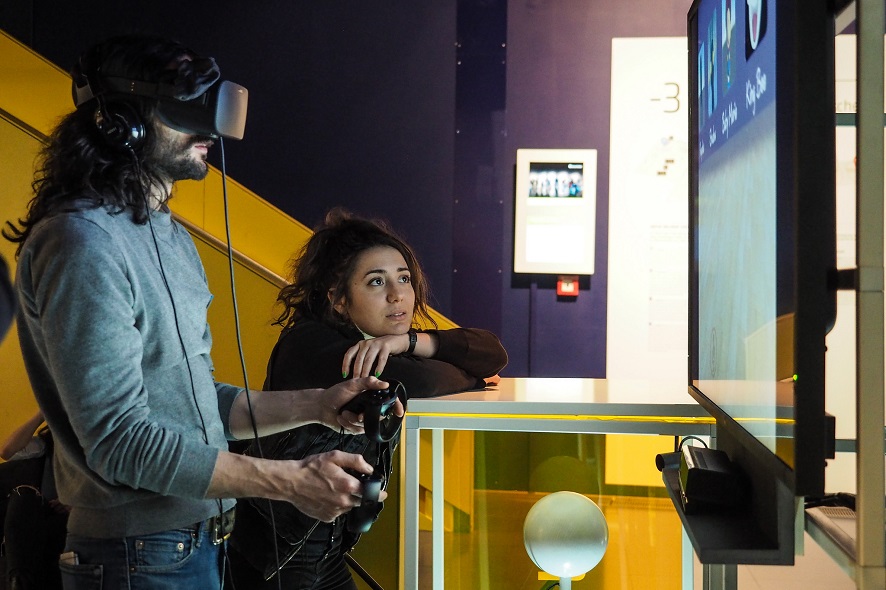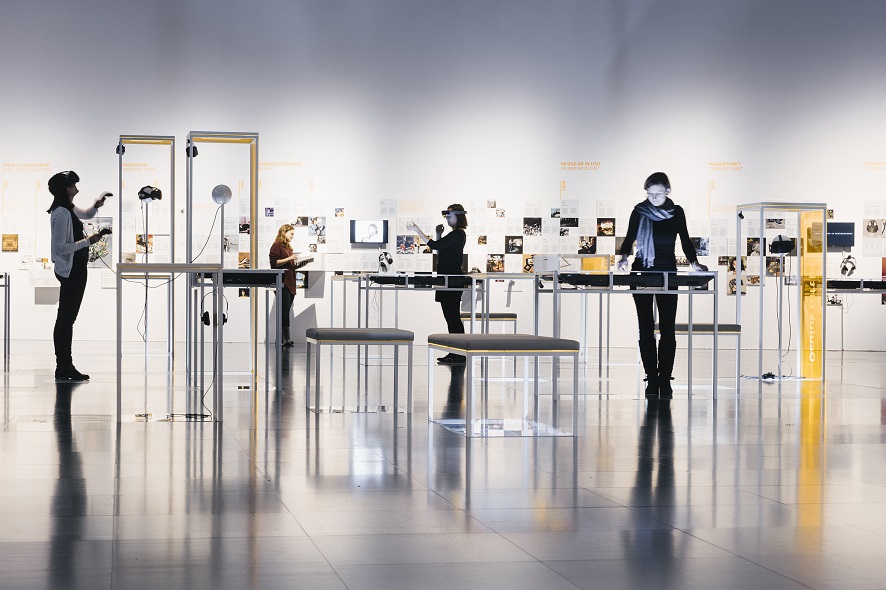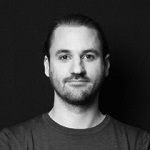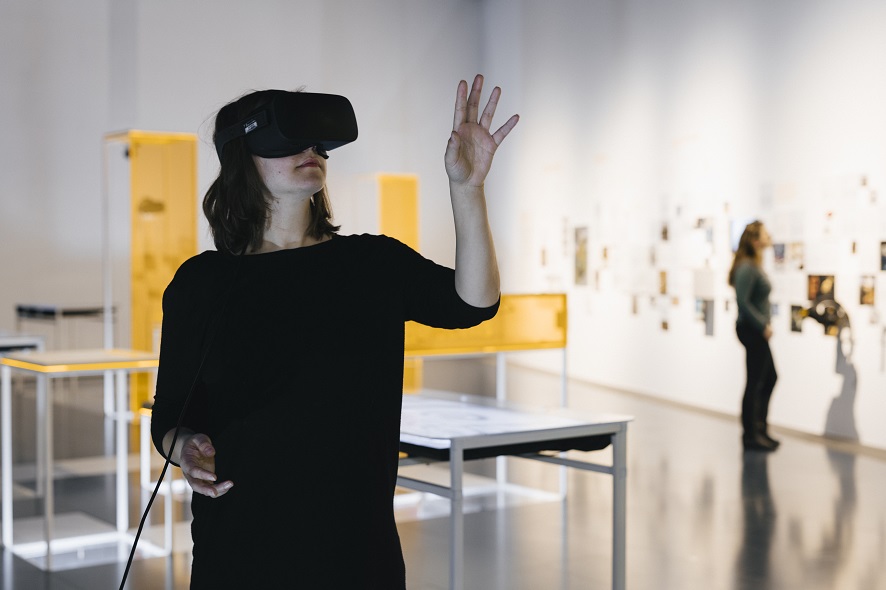What happens when our reality merges with the digital realm? When we don virtual reality (VR) headsets to immerse ourselves in digital worlds or utilize augmented reality (AR) to enrich our perception with data overlays?
The “Virtual Worlds – New Realities” themed weekend April 6-8, 2018 staged jointly by Ars Electronica and the Industrial Association of Upper Austria will delve into precisely these questions in talks, workshops and installations designed for hands-on experience. As a lead-in on Thursday, April 5th, we’ll host a Deep Space LIVE and a VR Chat as an enjoyable way for novices to get up to speed.
In the first part of our interview, Kristina Maurer, a producer at Ars Electronica, and artist Jürgen Ropp will give an account of their experiences with VR in art and the potential these new technologies hold. If you’d like to read on, find the second part – about Virtual Reality and gaming – here.

Credit: Florian Voggeneder
So, what do you have in store for us during this VR-themed weekend?
Kristina Maurer: The VR-themed weekend kicks off on Thursday, April 5th with a Deep Space LIVE about virtual and augmented reality. Among other features, we’ll present two new projects for the Center’s VRLab: a new artistic installation and a project pertaining to our cultural heritage. This Deep Space LIVE kicks off the weekend, which features workshops, various installations in the VRLab, themed tours, and talks on Saturday and Sunday.
Tell us about a few of the highlights?
Kristina Maurer: One highlight is definitely an installation entitled “The Lacuna Shifts” by Depart, a Viennese collective consisting of Leonhard Lass and Gregor Ladenhauf. Inspired by “Alice in Wonderland,” their work transports visitors into an alternative reality and confronts them with sounds, texts and a variety of images. This is a matter of deconstructing spaces and spatial experiences in virtual reality. Depart will also be present at the Deep Space LIVE on Thursday to talk about their work. Another highlight is the Virtual House of Medusa, a project by the Playful Interactive Environments Group at the Upper Austria University of Applied Sciences’ Hagenberg Campus, who have reconstructed the villa of a Roman patrician on the basis of finds from an archeological dig in nearby Enns. You can use VR to explore the house, reveal the respective historic layers and reassemble them like a jigsaw puzzle. This is a link-up to the Cultural Heritage focal-point theme at the Ars Electronica Center.

Credit: Martin Hieslmair
Besides being able to try out the new installations, will there also be a workshop that shows you how a VR installation is produced?
Kristina Maurer: This is the second time that we’re offering a workshop in cooperation with Jürgen Ropp, a student in Linz Art University’s Interface Cultures program, who specializes in vvvv programming. His installation entitled LOGIN, which has been on display at the Center for several months now, was also designed with vvvv, a programming environment for motion graphics, for audio data and video data, that you can use to generate data streams in real time. Over the course of this VR weekend, Jürgen will give us some insights into what this programming environment looks like and how he as an artist uses it in actual practice.
What are some of the other features on the weekend lineup?
Kristina Maurer: There’ll be a speech by Jürgen Hagler, director of Hagenberg’s Digital Arts program. His talk is entitled “Virtual and Real Spaces for Art, Culture and Gaming,” and he’ll be here with his Playful Interactive Environments research group that takes a playful approach to interaction and interactive possibilities, above all in digital environments. An important part of their research efforts is finding out how different people can interact in digital environments, and what interaction possibilities exist in large multi-user environments?

Credit: Florian Voggeneder
Why is the subject of VR so hot at the moment?
Kristina Maurer: I think that virtual and augmented reality are currently on the verge of a climax that will demonstrate whether this technology will establish itself or just turn out to be a flash in the pan. In any case, I can foresee VR becoming an important tool for manufacturers—for instance, in mobile presentations of products or industrial facilities. There’s also a lot of potential in the gaming sector, where VR has already become a factor and given a lot of people a taste of what this is all about. Another very exciting development is social virtual reality—that is, the concept of huge digital environments where people can meet & greet virtually. Be that as it may—I am convinced that overlaying our reality with data via augmented reality is something we will encounter much more frequently than VR in the next 10 years because the potential to interact directly in our everyday life is much greater.
What are the challenges with respect to VR and AR?
Kristina Maurer: The stumbling blocks at present are definitely of a technological nature. There’s no augmented reality headset now that really delivers freedom of movement; you have only a small, limited field of vision, which doesn’t take full advantage of this technology’s potential. The same goes for the graphical performance of the devices. The graphics produced by mobile phones and AR headsets haven’t yet reached the state at which reality and data seamlessly merge. The technological R&D still has a long way to go for these devices to become common accessories in everyday life.
One of the most important questions in the coming years will be how to develop augmented reality technology that really makes sense for users. On one hand, the equipment should function well on the technical level; on the other hand, it has to provide benefits to users. At the same time, there are health risks involved in wearing a headset right on your body for an extended period of time. But most urgently needed are sensible ways to use this technology in everyday life. We’re now at a time in which a lot of experimentation is being done, though it’s still not clear what future benefits this will bring. A lot of work has to go into constructing this bridge.
Jürgen, you’ll be conducting a workshop on vvvv during this VR-themed weekend. How do you work with this software, and what will you be getting across to workshop participants?
Jürgen Ropp: I use vvvv in many different areas since, as a programming language, it’s a superb tool for the implementation of certain concepts in various digital spheres. The diverse possibilities repeatedly open up exciting new approaches. The workshop itself will primarily concentrate on dealing with the vvvv programming environment. Participants will learn how to create and manipulate a 3-D scene, and to prepare it for use in conjunction with VR peripheral devices. So, in the short time available, I want to impart an impression of how people can take this further on their own.
What potential do you foresee for VR and AR in the art world?
Jürgen Ropp: The potential that I see is, first and foremost, in art’s capacity to nullify the boundaries within these technologies—thus, to enable people to get a new perspective on future changes and to have input into configuring them. I believe that art in particular can focus attention on these developments’ ancillary impact on people’s coexistence in society.
Increased proliferation will most probably be accompanied by cultural changes, comparable to those we’re familiar with from the rapid transition to the smartphone. Another task I think art has to carry out is the propagation of a certain degree of skepticism. In my opinion, it will still take some time for us to recognize the extent to which society will actually benefit from this progress. In any case, it’s an exciting preoccupation to follow all the new applications that are emerging—for example, in medicine and the natural sciences.
From a subjective standpoint, the primary benefit for me is the expansion of my possibilities to express myself. After all, VR technology gives you a means with which to experience imaginary images with an unprecedented degree of immersion and to share them with other people.

Credit: Robert Bauernhansl
What has to be kept in mind for this technology to be used sensibly in the future?
Jürgen Ropp: An essential aspect is the characteristic of VR to initially be experienced solely as an individual experience. Current efforts indicate that a tremendous amount of energy is being invested in the development of shared experiences within a virtual reality. Nevertheless, it should be remembered that these experiences remain virtual even when the boundary between real and virtual is increasingly blurred by the parallel link to real-world content effectuated by augmented reality. This is something that I go into in my VR installation, which I have conceived as—not exclusively but as an example of—a direct exchange between real and virtual worlds.

Kristina Maurer is an exhibition producer & developer best known for her exhibitions at the Ars Electronica Center. As a project manager, she develops shows in cooperation with the artistic director, the educational outreach department, and the exhibition designers & architects, produces collaborative exhibitions together with universities and scientific organizations such as the European Space Agency, MIT Media Lab’s Tangible Media Group, and Linz Art University, and works together closely with artists at the nexus of art, science and technology.

Jürgen Ropp is, first and foremost, a media artist, but at the moment he’s also completing his degree requirements in Linz Art University’s Interface Cultures master’s program. Substantively, he explores the area of interplay among art, science and technology, where he seeks ways to put scientific principles and technological achievements into new contexts.
The “Virtual Worlds – New Realities” themed weekend produced jointly by Ars Electronica and the Upper Austrian Industrial Association will run Friday to Sunday, April 6-8, 2018, at the Ars Electronica Center. Program details are available on our website. We’re getting things underway on Thursday, April 5th with a Deep Space LIVE and a VR Chat. For more info, click here.
To learn more about Ars Electronica, follow us on Facebook, Twitter, Instagram et al., subscribe to our newsletter, and check us out online at https://ars.electronica.art/news/en/.
